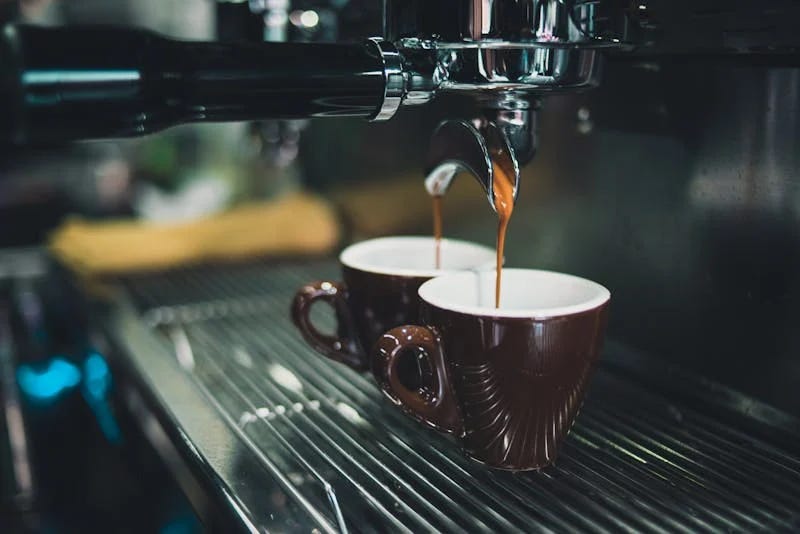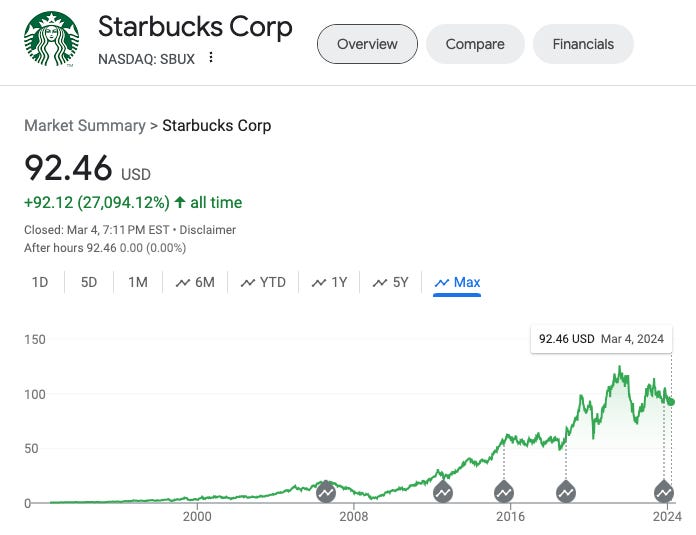How Starbucks Dominated the Market with Completely Mediocre Coffee
How do you win when you don’t have a unique product?
“At all costs, avoid competing in an industry where your product is just a commodity”.
Those words (or variants of them) are spoken in nearly every business school in the world. Would-be entrepreneurs and executives are regularly warned about the perils of creating a business with an undifferentiated product (e.g., a product or service that has no unique features or qualities to separate it from its competitors).
Think of things like construction materials, coffee, school supplies, food ingredients (wheat, sugar, oranges, etc.), or even airline travel.
Commodity industries are notoriously difficult to make a profit in. Just ask the CEO of a toothpick company. The obstacles to winning are legitimately scary:
The Lowest Price Usually Wins: When your product or service looks exactly like everyone else’s, price often becomes the primary factor for making a purchase
Tons of Competitors: Commodity products generally have low barriers to entry (as you don’t need any incredible breakthrough invention or patent to have a product that’s just as good as everyone else). The result = hundreds of businesses, big and small, all offering the same thing)
Limited Customer Loyalty: in the absence of a strong brand or quality difference, customers are likely to just switch to whoever can offer them the best deal (ex: do you really care what farm your fruit comes from?)
Limited Innovation Opportunity: Commodity products are hard to really improve. For example, if your company sells plastic straws, there’s only so much you can do to really claim your straw is superior to all the others out there. At some point, your argument is pretty flimsy even to you.
These reasons are exactly why it’s so utterly fascinating when you find a company that has managed to stand out from the commodity crowd.
Enter Starbucks…The Coffee King that somehow conquered the market with a completely mediocre “Cup of Joe”…
What’s so Weird about Coffee Markets?
Coffee is a perfect example of a commodity market. For one thing, it’s extremely common. Globally there are around ~1 billion coffee drinks, with over 2 billion cups of coffee consumed each day. In the US the coffee habit is even more common (65% of Americans drink coffee and have up to 3 cups a day). That’s a LOT of caffeine…
It’s also a hard product to make unique. Sure, you can prepare it a little differently but all coffee has essentially the same ingredients. There are only 2 main species of coffee beans in the world: Coffee Arabica (from Brazil) makes up ~75% of the world’s production, and Coffea Robusta (from Vietnam / Indonesia) makes up the remaining 25% of the world’s beans.
It’s hard to have a “secret sauce” when you’re all using the same basic ingredients. But that doesn’t stop everyone from the small corner cafe’ owned by a local mom/pop to the big retailers like Dunkin Donuts claiming to have the world’s “Best Cup of Coffee” (watch this clip from Elf for a good laugh)
And then there’s the competition. In the United States alone there are currently over 38,000 unique coffee businesses! (all trying to convince you that they’re better than the other 37,999 cafe’s out there)
But all of this is exactly what makes Starbucks an anomaly.
Enter Starbucks: The Coffee King
Starbucks was started in 1971 when 3 college friends launched a small coffee shop near Seattle’s Pike Place market. The name of the company was derived from Starbuck, Moby-Dick’s chief mate — not that the sailor had some association with coffee or tea, but because a friend of one of the founders like brand names beginning with “st” 🤷♂️
By 1987 Starbucks had 4 stores. This is when Howard Schultz, the now legendary Starbucks CEO, purchased the company. A year before Schultz had been touring Italy where he was fascinated by the success of Milan’s espresso bars. He decided he wanted to create a similar environment in the US to the coffee shops he had seen in Europe, a place where people would meet-up and hang out (not just take their order and go). By focusing on the “coffee experience” (instead of the coffee drink) Starbucks went through insane growth over the next 5 years.
By 1989 the company had 46 stores in the US. In 1992 (only 3 years later), Starbucks went public on the New York Stock Exchange. As of 2023, Starbucks has over 38,000 (!!!) stores worldwide. It is BY FAR the world’s largest coffee chain. Just check out the stock price over the company history…
The Secret Ingredient to a Mediocre Cup of Coffee…
So what (besides caffeine) fueled Starbuck’s to the top of the heap in an incredibly competitive market?
The answer: Starbucks realized that the key to winning in a “commodity market” was to focus on the customer experience, not their product.
While in Italy, Howard Schultz (Starbucks CEO) had realized that what made Italian cafes so different from what you saw in the US was the environment. People didn’t just order and rush on with their day like they were in some frenetic checkout line. They sat down with friends (or work), sipped at their coffee, and would spend hours at the store. The Italian cafes weren’t just places to buy food. They were places to just hang out.
Starbucks started calling this their “3rd Space” strategy. They wanted their cafes to be the main place you spent your time outside of work + home. To do that they focused far more on the environment of the cafe itself, instead of worrying too much about the caliber of the coffee. “Retail is detail” and Starbucks puts an extreme emphasis on even the most minute details.
Here are some examples of what this looks like in action:
Serious Employee Investment ($$$): Starbucks regularly spends more on employee training than on ads or marketing. The result = 120% less turnover than other coffee shops. This means that the average Starbucks barista is likely to be much more experienced (and customer-friendly) than your typical cafe worker.
Every Customer’s Order is “Unique”: Starbucks has created a phenomenon where every customer feels like they have this completely unique order that is a reflection of their personality and identity. Remember the “You’ve got Mail Scene” where Starbucks is described as a “place where people with no decision-making skills will make six decisions just to order a cup of coffee”. Customers can feel for a moment that they matter as an individual! And Starbucks feeds into this by making sure that everyone’s name is written on their order. That doesn’t sound like much, but when you consider that the company serves over 100M customers each week, that’s actually a pretty impressive feat to greet each and every customer by name (fun side note: I’ve been told that barista’s are actually trained to occasionally misspell customer’s names because it makes the customer feel like they’re part of an inside joke)
Measuring the Minutia: Starbucks meticulously measures things like coffee temperature, how long it takes to get an order, and how loud the music in their store is. These are viewed as “experience metrics” and the company obsesses over them
Being Proud of How Many People don’t Order Coffee: One of the stranger metrics Starbuck’s tracks is how many people come into their stores and don’t order. What’s odd is that Starbucks is actually proud of how big this number is! They know that if they become most people’s “3rd space” (the place to hang out) that the orders will follow (after all, you can only hang out somewhere without eventually giving into your hunger…)
A Community Atmosphere: Walk into any Starbucks in your city and the baristas are smiling, there’s a place for you to sit down and plug into the free WiFi, and the cafe music is curated to be entertaining but not distracting.
Be Like McDonald’s (kind of): Starbucks famously does not franchise its stores. It wants 100% operating control over all the daily operations so that every single shop feels like every other shop, no matter where in the world you are. It reminds me of my MBA Operations professor who told me that his favorite thing to do when traveling overseas is to eat at McDonalds. Not because the food is particularly notable, but because it’s incredible that no matter where in the world you go, McDonald’s always tastes the same. It’s a business miracle. Starbucks feels exactly the same (warm, comfortable, and familiar) no matter what city you’re in. And that is extremely intentional.
Final Thoughts…
Starbucks is proof that, contrary to most advice taught in MBA schools, you actually can thrive in a commodity market. You just have to focus all of your attention on everything except the product itself.
Like most great business strategies, it’s actually a little counterintuitive.
This is what “customer experience design” is all about, and why it’s such a powerful force. If you’re interested in reading more on using “experience” as a business edge, I’d highly recommend checking out the following:
"The Experience Economy: Competing for Customer Time, Attention, and Money" (by B. Joseph Pine II and James H. Gilmore)
Empathy in Action: How to Deliver Great Customer Experiences at Scale (by Tony Bates + Dr. Natalie Petouhoff)
(Lastly: Credit to Marcus Bertilson, Weave’s Chief Strategy Officer, for making us aware of the Starbucks story)
If you want more articles like this check out our new Unwritten website!









Fun read! You know it's true when you're not personally a 'Starbies guy' and can appreciate what they have going - although I'll admit the new pistachio latte I tried was tasty. It's 100% mediocre coffee, but CX is all.